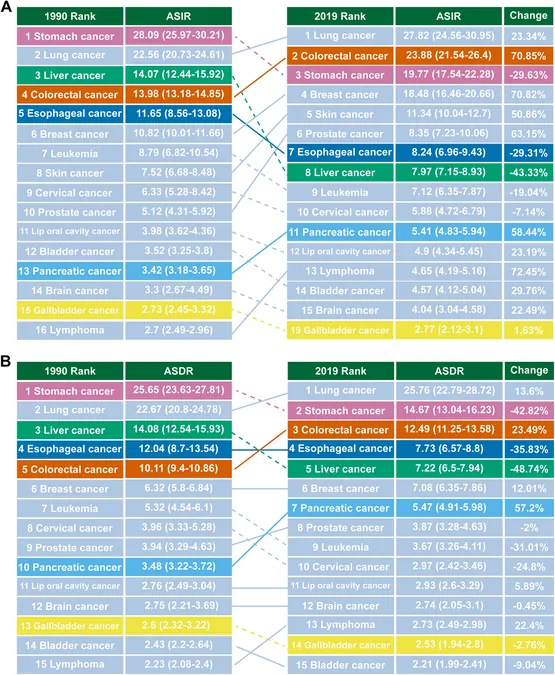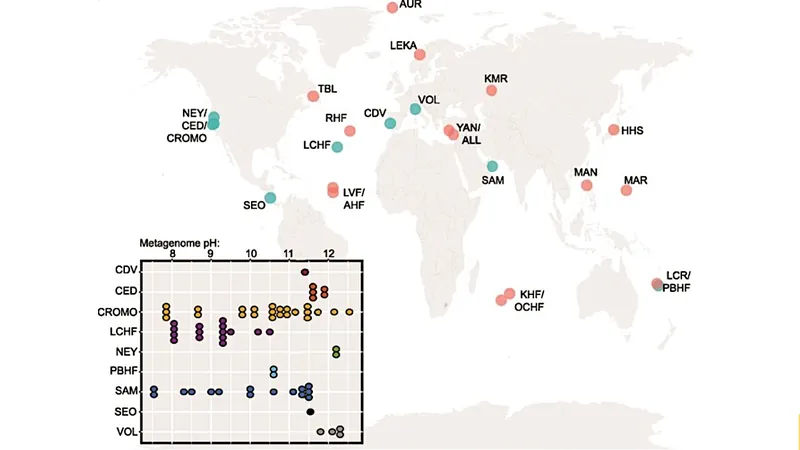
The Rising Tide of Gastrointestinal Cancers in Asia: Facts from 1990 to 2019 You Need to Know!
2025-04-08
Author: Jia
Recent research has unveiled a staggering rise in the burden of gastrointestinal (GI) cancers across Asia from 1990 to 2019. Data sourced from the Global Burden of Disease (GBD) 2019 Database highlights how these cancers account for a major slice of the cancer pie, representing 23% of all cancer diagnoses globally, with Asia bearing over half these cases.
The methodology employed in this study utilized sophisticated tools like the Cause of Death Ensemble model (CODEm) and the Spatio-Temporal Gaussian Process Regression (ST-GPR) to derive accurate and consistent estimations of cancer rates across various regions. It meticulously charted gastrointestinal cancers like colorectal, gastric, liver, and pancreatic cancers, with particular attention to their incidence and mortality rates over the years.
The Grim Statistics
Shockingly, GI cancers accounted for 35.9% of all cancers in Asia in 2019, showcasing a concerning trend of increased cases, particularly in colorectal and gastric cancers. While gastric cancer was the leading cause of cancer-related deaths in 2019, colorectal cancer has overtaken it in prevalence, marking a significant shift. The Asian continent faced an alarming statistic: 43% of all cancer-related deaths were tied to GI cancers, solidifying the need for immediate medical and preventive action.
Between 1990 and 2019, the Age-Standardized Incidence Rate (ASIR) for colorectal cancer surged to 23.88 per 100,000 people, while pancreatic cancer saw an increase to 5.41 per 100,000. Conversely, some cancers, including esophageal and liver cancers, witnessed a decline in incidence but still posed significant mortality risks.
Age and Gender Patterns
Delving deeper into the demographics, the data revealed that those aged 60 and above were the most affected—accounting for over 60% of cases. Notably, men are disproportionately affected by these cancers, particularly colorectal and esophageal cancers, which suggests lifestyle factors such as smoking and dietary habits could be significant contributors.
A striking finding was that while male-to-female ratios for most GI cancers favored men, gallbladder cancer presented a unique case, being more prevalent in women.
Geographic Disparities
Geographically, Mongolia consistently emerged as one of the countries most afflicted by GI cancers, with death rates soaring above 200 per 100,000 population. Meanwhile, countries like Vietnam and Kazakhstan have also seen a burgeoning increase in colorectal and pancreatic cancer rates, respectively. The variability across nations underscores the differing healthcare access and lifestyle choices present in the region.
Lifestyle Factors at Play
In digesting the risk factors, it became clear that dietary choices played a pivotal role in the rise of colorectal cancer mortality. Diets low in calcium and high in processed meats posed significant risks, while smoking emerged as a chief factor contributing to esophageal cancer. Impressively, high body mass index (BMI) levels—a reflection of unhealthy lifestyles—saw a marked rise in GI cancer-related deaths.
What Lies Ahead
The data from this comprehensive analysis serve as a wake-up call for policymakers and public health officials. With rising rates of GI cancers, there’s an urgent need for targeted prevention strategies, public health campaigns focusing on dietary choices, smoking cessation, and improved screening for early detection.
As we forge ahead, the experiences of countries like Japan and Korea, which have successfully rolled out nationwide screening programs for gastric cancer, can serve as a beacon for others in Asia. However, the significant burden of cancer indicates that more robust policies are necessary to address health disparities and improve access to care in less developed nations.
In summary, while we have witnessed some progress against certain cancers, GI cancers represent a growing health threat in Asia, one that requires our immediate attention. Ongoing surveillance and targeted interventions will be vital in curbing this alarming trend. Will Asia rise to the challenge? Only time will tell.




 Brasil (PT)
Brasil (PT)
 Canada (EN)
Canada (EN)
 Chile (ES)
Chile (ES)
 Česko (CS)
Česko (CS)
 대한민국 (KO)
대한민국 (KO)
 España (ES)
España (ES)
 France (FR)
France (FR)
 Hong Kong (EN)
Hong Kong (EN)
 Italia (IT)
Italia (IT)
 日本 (JA)
日本 (JA)
 Magyarország (HU)
Magyarország (HU)
 Norge (NO)
Norge (NO)
 Polska (PL)
Polska (PL)
 Schweiz (DE)
Schweiz (DE)
 Singapore (EN)
Singapore (EN)
 Sverige (SV)
Sverige (SV)
 Suomi (FI)
Suomi (FI)
 Türkiye (TR)
Türkiye (TR)
 الإمارات العربية المتحدة (AR)
الإمارات العربية المتحدة (AR)